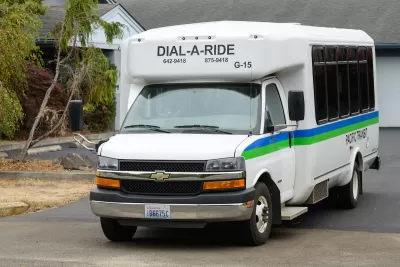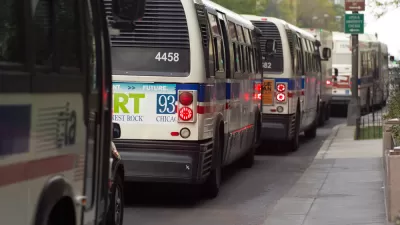On-demand services can’t scale successfully without massive government subsidies, and could obscure the impacts of car-centric sprawl.

As more cities opt for on-demand transit services, often labeled ‘microtransit,’ to supplement or even replace fixed-route transit, David Zipper highlights one major problem with relying too heavily on microtransit.
For Zipper, the surface benefits of microtransit are obvious. “The allure of cheap, responsive, door-to-door transit service is seductive, particularly for public leaders eager to ‘reimagine’ fixed-route bus service that fails to inspire.”
The hard part comes when public officials try to scale microtransit service without breaking their budget, limiting how many trips people can take, or morphing into something that looks a lot like fixed-route service.
Whereas fixed-route service offers economies of scale—“As long as empty bus seats are available, each new rider brings new revenue to the transit agency while incurring minimal added costs, thereby reducing the subsidy required for each trip”—“An increase in microtransit trips can quickly overwhelm the system’s capacity, in part because vans have only a handful of seats, but especially because passengers’ itineraries often do not overlap.”
Ultimately, the system doesn’t work as public transit without significant public subsidies. “In Los Angeles, for example, a microtransit ride costs passengers only $1, but each one receives a $42 subsidy.”
Additionally, Zipper notes, microtransit “shields people from the inefficiency of car-centric land use.” Ultimately, “For the sake of the planet, as well as efficiency, transportation should be more expensive in places that are difficult to access without a car.”
FULL STORY: On-Demand Microtransit Can’t Escape This Big Problem

Planetizen Federal Action Tracker
A weekly monitor of how Trump’s orders and actions are impacting planners and planning in America.

Congressman Proposes Bill to Rename DC Metro “Trump Train”
The Make Autorail Great Again Act would withhold federal funding to the system until the Washington Metropolitan Area Transit Authority (WMATA), rebrands as the Washington Metropolitan Authority for Greater Access (WMAGA).

The Simple Legislative Tool Transforming Vacant Downtowns
In California, Michigan and Georgia, an easy win is bringing dollars — and delight — back to city centers.

The States Losing Rural Delivery Rooms at an Alarming Pace
In some states, as few as 9% of rural hospitals still deliver babies. As a result, rising pre-term births, no adequate pre-term care and harrowing close calls are a growing reality.

The Small South Asian Republic Going all in on EVs
Thanks to one simple policy change less than five years ago, 65% of new cars in this Himalayan country are now electric.

DC Backpedals on Bike Lane Protection, Swaps Barriers for Paint
Citing aesthetic concerns, the city is removing the concrete barriers and flexposts that once separated Arizona Avenue cyclists from motor vehicles.
Urban Design for Planners 1: Software Tools
This six-course series explores essential urban design concepts using open source software and equips planners with the tools they need to participate fully in the urban design process.
Planning for Universal Design
Learn the tools for implementing Universal Design in planning regulations.
Smith Gee Studio
City of Charlotte
City of Camden Redevelopment Agency
City of Astoria
Transportation Research & Education Center (TREC) at Portland State University
US High Speed Rail Association
City of Camden Redevelopment Agency
Municipality of Princeton (NJ)





























